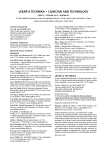SOFTWARE PACKAGE FOR ELECTROPHYSIOLOGICAL MODELING OF NEURONAL AND CARDIAC EXCITABLE CELLS
The software package described in this article is dedicated for educational and research purposes in the area of electrophysiological cell membrane properties modeling. The designed and created software package offers a selection of several models of nerve fibre membrane, cortical neuron models and various models of heart cells. The model properties and simulation conditions can be set interactively. Consequently, generation of an action potential (AP) on a particular membrane can be observed. The software allows computation and graphical visualization of actual time courses of model state variables, particularly the membrane potential, membrane currents and other model variables. Eventually, additional important characteristics are evaluated from the output data, such as AP duration (APD) of heart cells or AP frequency of cortical neurons.
Keywords:
electrophysiological modeling, software package, neuron, heart cell, cell membrane models, action potential
Autoři:
Elena Cocherová 1,2; Jozef Púčik 1; Martin Nováček 1
Působiště autorů:
Institute of Electronics and Photonics, FEI STU, Bratislava, Slovak Republic
1; Institute of Measurement Science, Slovak Academy of Sciences, Bratislava, Slovak Republic
2
Vyšlo v časopise:
Lékař a technika - Clinician and Technology No. 2, 2012, 42, 57-60
Kategorie:
Conference YBERC 2012
Souhrn
The software package described in this article is dedicated for educational and research purposes in the area of electrophysiological cell membrane properties modeling. The designed and created software package offers a selection of several models of nerve fibre membrane, cortical neuron models and various models of heart cells. The model properties and simulation conditions can be set interactively. Consequently, generation of an action potential (AP) on a particular membrane can be observed. The software allows computation and graphical visualization of actual time courses of model state variables, particularly the membrane potential, membrane currents and other model variables. Eventually, additional important characteristics are evaluated from the output data, such as AP duration (APD) of heart cells or AP frequency of cortical neurons.
Keywords:
electrophysiological modeling, software package, neuron, heart cell, cell membrane models, action potential
Zdroje
[1] Cocherová, E. Refractory period determination in the Hodgkin – Huxley model of the nerve fibre membrane. In: 4th Electronic Circuits and System Conference, Bratislava, September 11-12 2003, p. 171–174.
[2] Cocherová, E., Zahradníková, A. Simulation of the effect of changed ionic conductances on the parameters of heart myocyte action potential. Physiological Research, 2008, vol. 57, no. 2, p. 11P–12P.
[3] Frankenhaeuser, B., Huxley, A. F. The action potential in the myelinated nerve fibre of Xenopus Laevis as computed on the basis of voltage clamp data. Journal of Physiology, 1964, vol. 171, p. 302–315.
[4] Hodgkin, A. L., Huxley, A. F. A quantitative description of membrane current and its application to conduction and excitation in nerve. Journal of Physiology, 1952, vol. 117, p. 500–544.
[5] Hund, T. J., Rudy, Y. Rate dependence and regulation of action potential and calcium transient in a canine cardiac ventricular cell model. Circulation, 2004, vol. 110, p. 3168–3174.
[6] Luo, Ch., Rudy, Y. A model of the ventricular cardiac action potential. Depolarization, repolarization, and their interaction. Circulation Research, 1991, vol. 68, p. 1501–1526.
[7] Michaels, D. C., Matyas, E. P., Jalife, J. A mathematical model of the effects of acetylcholine pulses on sinoatrial pacemaker activity. Circulation Research, 1984, vol. 55, p. 89–101.
[8] Nygren, A., Fiset, C., Firek, L., Clark, J. W., Lindblad, D. S., Clark, R. B., Giles, W. R. Mathematical model of an adult human atrial cell: the role of K+ currents in repolarization. Circulation Research, 1998, vol. 82, p. 63-81.
[9] O'Hara, T., Virág, L., Varró, A., Rudy, Y. Simulation of the undiseased human cardiac ventricular action potential: model formulation and experimental validation. PLoS Computational Biology, 2011, vol. 7, no. 5, e1002061. [10] Rattay, F. Electrical nerve stimulation. Springer-Verlag, Wien, 1990.
[11] Trappenberg, T. P. Fundamentals of computational neuroscience. Oxford University Press, Oxford, 2002.
[12] Wilson, H. R. Simplified dynamics of human and mammalian neocortical neurons. Journal Theoretical Biology, 1999, vol. 200, p. 375–388.
[13] Wilson, H. R. Spikes, decisions, and actions. The dynamical foundations of neuroscience. Oxford University Press, Oxford, 2003.
Štítky
BiomedicínaČlánok vyšiel v časopise
Lékař a technika

2012 Číslo 2
Najčítanejšie v tomto čísle
- MECHANICAL MODEL OF THE CARDIOVASCULAR SYSTEM: DETERMINATION OF CARDIAC OUTPUT BY DYE DILUTION
- MATLAB AND ITS USE FOR PROCESSING OF THERMOGRAMS
- The Fifth Biomedical Engineering Conference of Young Biomedical Engineers and Researchers
- VALUATION METHODOLOGY FOR MEDICAL DEVICES
